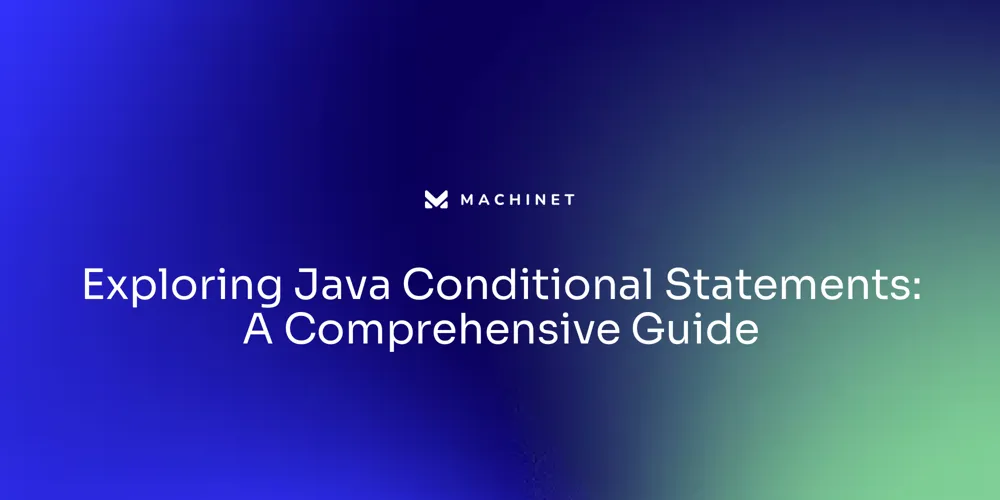
Table of Contents
- The if Statement in Java
- The if-else Statement in Java
- The if-else-if Ladder in Java
- The switch Statement in Java
Introduction
The article explores the different types of conditional statements in Java, namely the if statement, the if-else statement, the if-else-if ladder, and the switch statement. It highlights the importance of these control flow mechanisms in directing program execution based on dynamic conditions.
The article also mentions how mastering these constructs is essential for understanding more advanced features in Java and writing efficient and maintainable code. As Java continues to evolve with new updates and features, developers need to stay informed to leverage the latest trends and best practices.
The if Statement in Java
In Java, the if statement is a crucial control flow mechanism, enabling conditional execution of code segments. Specifically, let's examine its structure:
java
if (condition) {
// block of code to be executed if the condition is true
}
Here, the condition evaluates to either true or false, dictating whether the subsequent code block runs. Consider a scenario where x is an integer set to 10.
Using an if statement, we can implement logic to display a message if x exceeds 5:
java
int x = 10;
if (x > 5) {
System.out.println("x is greater than 5");
}
In this example, since x is indeed greater than 5, the output will affirm that 'x is greater than 5'. Such conditional statements are not only foundational for basic operations but also pivotal in more complex situations such as feature toggling. Feature toggling involves using a variable to switch on or off certain functionalities without deploying multiple application versions, thus saving time and reducing complexity.
Furthermore, understanding the if statement is foundational for grasping more advanced Java features, like pattern matching, which simplifies data extraction and operations on data structures. As Java evolves, with updates like those seen in the recent JobRunr and Spring releases, mastering these basic constructs remains essential. They are the building blocks for writing responsive and intelligent Java applications, as they allow developers to direct the program flow based on dynamic conditions.
The if-else Statement in Java
Conditional statements are the backbone of programming, enabling the execution of specific code blocks based on boolean conditions. The if-else statement in Java is a fundamental construct that directs the flow of execution.
It operates on a simple principle: if the given condition evaluates to true, the code within the if clause is executed; otherwise, the else block takes over. For example, consider the following Java snippet:
java
int number = 3;
if (number % 2 == 0) {
System.out.println("Number is even");
} else {
System.out.println("Number is odd");
}
In this case, the output would be "Number is odd" because the remainder of number divided by 2 is not zero.
This illustrates how if-else statements control program flow based on evaluations. It's not just about true or false; it's about making decisions in code that lead to different outcomes.
While the if-else statement is a staple in conditional logic, other constructs like the switch statement can offer a more scalable solution for multiple conditions. However, with the introduction of Java Development Kit 23 (JDK), attention has been drawn to the Vector API and other features, such as 'restricted methods' in the Foreign Function & Memory API. The latter requires special attention due to its potential to become inaccessible in future JVM versions without specific command-line options. As we embrace these advancements, it's crucial to remember the core concepts of conditional logic shared across programming languages. Whether it's the simplicity of if-else or the complexity of switch, understanding these constructs is key to writing efficient and maintainable code.

The if-else-if Ladder in Java
Java's if-else-if ladder is a fundamental control flow mechanism, enabling the execution of specific code blocks based on the truthfulness of sequential conditions. It is structured as a cascade of if-else statements, where each condition is evaluated in turn. If a condition evaluates to true, the associated code block runs, and the subsequent conditions are skipped.
If no conditions are true, the else block's code is executed, serving as a default action. For instance, consider an integer variable x with a value of 7. Using the if-else-if ladder:
java
if (x < 5) {
System.out.println("x is less than 5");
} else if (x < 10) {
System.out.println("x is less than 10");
} else {
System.out.println("x is greater than or equal to 10");
}
In this scenario, the second condition is true (x < 10), so "x is less than 10" is printed to the console.
The if-else-if ladder's readability and intuitiveness can be further enhanced by recent advancements in Java, such as pattern matching introduced in Java 14 and improved in subsequent versions. Pattern matching allows binding variables to a value based on a defined pattern, streamlining code comprehension and maintenance. Moreover, the evolution of Java's switch construct, with the introduction of Switch Expressions in Java 14 and the anticipated inclusion of primitive types in patterns by Java 23, provides alternative approaches to handling multiple conditions with increased expressiveness and less verbosity.
This shift towards more modern control flow structures is indicative of the ongoing innovations in Java, as developers seek more efficient and readable coding paradigms. As the Java landscape continues to evolve, with changes like the Foreign Function & Memory API's restricted methods, it's crucial for developers to stay informed about the latest trends and updates to write better, more secure code. The if-else-if ladder remains a staple structure, but the emergence of new features and best practices offers exciting possibilities for writing cleaner and more efficient Java code.
The switch Statement in Java
A switch statement in Java serves as a more concise alternative to a series of if-else statements, allowing for clear and efficient execution of code blocks based on the value of an expression. Here's the basic structure:
java
switch (expression) {
case value1:
// Code executes if expression equals value1
break;
case value:
// Code executes if expression equals value
break;
// Additional cases
default:
// Code executes if no case matches
}
The evaluated expression directs the flow to the matching case block.
Without a matching case, the default code block runs. Consider this scenario:
java
int dayOfWeek = 3;
switch (dayOfWeek) {
case 1:
System.out.println("Monday");
break;
case 2:
System.out.println("Tuesday");
break;
case 3:
System.out.println("Wednesday");
break;
// More cases
default:
System.out.println("Invalid day");
}
Here, dayOfWeek is 3, triggering the execution of the "Wednesday" block.
It's crucial to remember that the break statement is optional but recommended to prevent fall-through behavior, where subsequent case statements execute until a break is encountered or the switch concludes. Java's evolution has introduced enhancements to the switch statement, increasing its power and reducing verbosity. For instance, Java 21, releasing on September 19, 2023, will include support for record patterns, enabling functional programming patterns akin to those in Kotlin or Rust. With these advancements, switch statements can now handle more complex data types, including nulls, and even return values without needing break statements, as demonstrated with Switch expressions.

Conclusion
The article explores the different types of conditional statements in Java, namely the if statement, the if-else statement, the if-else-if ladder, and the switch statement. These control flow mechanisms are essential for directing program execution based on dynamic conditions.
They serve as the building blocks for writing efficient and maintainable code. The if statement allows for conditional execution of code segments based on a boolean condition.
It is foundational for basic operations and more complex scenarios like feature toggling. Understanding the if statement is crucial for grasping advanced Java features such as pattern matching.
The if-else statement directs program flow based on evaluations, allowing for different outcomes based on true or false conditions. While it remains a staple in conditional logic, other constructs like the switch statement provide a more scalable solution for multiple conditions.
Java's if-else-if ladder enables the execution of specific code blocks based on sequential conditions. It offers readability and intuitiveness, enhanced by recent advancements like pattern matching. The evolution of the switch construct with switch expressions provides alternative approaches to handling multiple conditions with increased expressiveness. In conclusion, mastering these conditional statements is essential for understanding more advanced features in Java and writing efficient and maintainable code. As Java continues to evolve with new updates and features, developers need to stay informed to leverage the latest trends and best practices. By leveraging these control flow mechanisms effectively, developers can write responsive and intelligent Java applications that direct program flow based on dynamic conditions.
Master Java's conditional statements and write efficient and maintainable code.
AI agent for developers
Boost your productivity with Mate. Easily connect your project, generate code, and debug smarter - all powered by AI.
Do you want to solve problems like this faster? Download Mate for free now.




